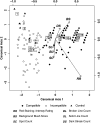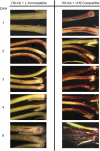Induced epidermal permeability modulates resistance and susceptibility of wheat seedlings to herbivory by Hessian fly larvae
- PMID: 21659664
- PMCID: PMC3170548
- DOI: 10.1093/jxb/err160
Induced epidermal permeability modulates resistance and susceptibility of wheat seedlings to herbivory by Hessian fly larvae
Abstract
Salivary secretions of neonate Hessian fly larvae initiate a two-way exchange of molecules with their wheat host. Changes in properties of the leaf surface allow larval effectors to enter the plant where they trigger plant processes leading to resistance and delivery of defence molecules, or susceptibility and delivery of nutrients. To increase understanding of the host plant's response, the timing and characteristics of the induced epidermal permeability were investigated. Resistant plant permeability was transient and limited in area, persisting just long enough to deliver defence molecules before gene expression and permeability reverted to pre-infestation levels. The abundance of transcripts for GDSL-motif lipase/hydrolase, thought to contribute to cuticle reorganization and increased permeability, followed the same temporal profile as permeability in resistant plants. In contrast, susceptible plants continued to increase in permeability over time until the entire crown of the plant became a nutrient sink. Permeability increased with higher infestation levels in susceptible but not in resistant plants. The ramifications of induced plant permeability on Hessian fly populations are discussed.
Published by Oxford University Press on behalf of the Society of Experimental Biology, 2011.
Figures






Similar articles
-
Hessian fly larval feeding triggers enhanced polyamine levels in susceptible but not resistant wheat.BMC Plant Biol. 2015 Jan 16;15:3. doi: 10.1186/s12870-014-0396-y. BMC Plant Biol. 2015. PMID: 25592131 Free PMC article.
-
Changes in properties of wheat leaf cuticle during interactions with Hessian fly.Plant J. 2010 Jul 1;63(1):31-43. doi: 10.1111/j.1365-313X.2010.04229.x. Epub 2010 Apr 16. Plant J. 2010. PMID: 20409001
-
Rapid mobilization of membrane lipids in wheat leaf sheaths during incompatible interactions with Hessian fly.Mol Plant Microbe Interact. 2012 Jul;25(7):920-30. doi: 10.1094/MPMI-01-12-0022-R. Mol Plant Microbe Interact. 2012. PMID: 22668001 Free PMC article.
-
Mobilization of lipids and fortification of cell wall and cuticle are important in host defense against Hessian fly.BMC Genomics. 2013 Jun 26;14:423. doi: 10.1186/1471-2164-14-423. BMC Genomics. 2013. PMID: 23800119 Free PMC article.
-
Gall midges (Hessian flies) as plant pathogens.Annu Rev Phytopathol. 2012;50:339-57. doi: 10.1146/annurev-phyto-072910-095255. Epub 2012 May 29. Annu Rev Phytopathol. 2012. PMID: 22656645 Review.
Cited by
-
Genetic and phenotypic responses of temperature-independent Hessian fly-resistant durum wheat to larval attack during heat stress.BMC Plant Biol. 2025 Feb 17;25(1):210. doi: 10.1186/s12870-025-06226-1. BMC Plant Biol. 2025. PMID: 39962422 Free PMC article.
-
Over Time Changes in the Transcriptomic Profiles of Tomato Plants with or Without Mi-1 Gene During Their Incompatible or Compatible Interactions with the Whitefly Bemisia tabaci.Plants (Basel). 2025 Mar 28;14(7):1054. doi: 10.3390/plants14071054. Plants (Basel). 2025. PMID: 40219123 Free PMC article.
-
Hessian fly larval feeding triggers enhanced polyamine levels in susceptible but not resistant wheat.BMC Plant Biol. 2015 Jan 16;15:3. doi: 10.1186/s12870-014-0396-y. BMC Plant Biol. 2015. PMID: 25592131 Free PMC article.
-
Comparative Hessian Fly Larval Transcriptomics Provides Novel Insight into Host and Nonhost Resistance.Int J Mol Sci. 2021 Oct 25;22(21):11498. doi: 10.3390/ijms222111498. Int J Mol Sci. 2021. PMID: 34768928 Free PMC article.
-
Multiple molecular defense strategies in Brachypodium distachyon surmount Hessian fly (Mayetiola destructor) larvae-induced susceptibility for plant survival.Sci Rep. 2019 Feb 22;9(1):2596. doi: 10.1038/s41598-019-39615-2. Sci Rep. 2019. PMID: 30796321 Free PMC article.
References
-
- Anderson KG, Harris MO. Leaf growth signals the onset of effective plant resistance against Hessian fly larvae. Entomologia Experimentalis et Applicata. 2008;128:184–195.
-
- Anderson KG, Harris MO. Does r-gene resistance allow wheat to prevent plant growth effects associated with Hessian fly (Diptera: Cecidomyiidae) attack? Journal of Economic Entomology. 2006;99:1842–1853. - PubMed
-
- Anderson KM, Kang Q, Reber J, Harris MO. No fitness cost for wheat's H-gene mediated resistance to Hessian fly (Diptera: Cecidomyiidae) Journal of Economic Entomology. 2011 (in press) - PubMed

